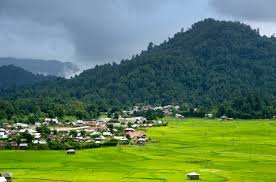
Top 5 Monsoon Destinations in Northeast India – A Lush Escape with Gofero !
Northeast India transforms into a lush, vibrant paradise during the monsoon season, offering a unique and refreshing escape for nature lovers. While some areas might experience heavy rainfall and potential disruptions, many destinations become even more magical with gushing waterfalls, misty mountains, and emerald landscapes.
Here are the top 5 monsoon destinations in Northeast India for a truly lush escape:
Meghalaya (Shillong, Cherrapunji, Mawsynram, Dawki, Mawlynnong):
Why in Monsoon: Aptly called the "Abode of Clouds," Meghalaya truly comes alive during the monsoon. Cherrapunji and Mawsynram, two of the wettest places on Earth, showcase breathtaking waterfalls (like Nohkalikai Falls and Seven Sisters Falls) at their peak, creating a dramatic and awe-inspiring spectacle. The living root bridges are also particularly vibrant and mystical in the rain. Shillong, the capital, becomes "Scotland of the East" with its rolling green hills and misty air.
Highlights: Witnessing colossal waterfalls, exploring the unique living root bridges, a boat ride on the crystal-clear Umngot River in Dawki (though water levels might be higher in peak monsoon, check local conditions), and visiting Mawlynnong, Asia's cleanest village, which is even more picturesque with fresh rain.
Ziro Valley, Arunachal Pradesh:
Why in Monsoon: This hidden gem in Arunachal Pradesh becomes a verdant wonderland during the rainy season. The lush green paddy fields and mist-covered hills offer a serene and picturesque landscape. It's a magical experience that brings you closer to nature's raw beauty.
Highlights: Enjoying the stunning scenery, interacting with the friendly Apatani tribe, and experiencing the tranquility of this less-commercialized destination. While the Ziro Music Festival is usually in September/October, the monsoon transforms the valley into a green carpet.
Dzukou Valley, Nagaland:
Why in Monsoon: While the famous Dzukou Lily blooms after the monsoon (around June-July), the valley itself is an enchanting sight during the rainy season. The rolling green hills are covered in a thick carpet of various wildflowers, and the mist adds to its ethereal charm, making it a dream destination for trekkers and nature enthusiasts.
Highlights: Trekking through lush meadows and dense forests, witnessing the vibrant wildflowers, and enjoying the serene and secluded atmosphere of this "Valley of Flowers."
Gangtok & Pelling, Sikkim:
Why in Monsoon: Sikkim's capital, Gangtok, becomes even more captivating amidst the monsoon mists. The surrounding hills turn vibrant green, and the city exudes a tranquil charm. Pelling, perched at a higher altitude, offers stunning views of waterfalls and lush greenery.
Highlights: Exploring Buddhist monasteries (like Rumtek), enjoying the panoramic views, and experiencing the unique blend of culture and nature. While views of Kanchenjunga might be obscured by clouds, the overall atmosphere is incredibly serene.
Majuli Island, Assam:
Why in Monsoon: As the Brahmaputra River swells, Majuli, the world's largest river island, transforms into a unique "floating dreamland." The stilt houses peeking out from the floodwaters and the expansive waterways create a distinctive landscape.
Highlights: Experiencing the unique riverine culture, visiting the Vaishnavite monasteries (Satras), and observing the slow, peaceful rhythm of island life amidst the rain-soaked surroundings.
Important Tips for Monsoon Travel in Northeast India:
Weather Conditions: Be prepared for heavy rainfall. Some areas, especially in Meghalaya, experience very high precipitation.
Road Conditions: Landslides and road blockages can occur, especially in hilly areas. Keep your itinerary flexible.
Packing: Carry waterproof clothing, sturdy waterproof footwear, umbrellas, insect repellent, and waterproof bags for electronics and valuables.
Accommodation: Book accommodations in advance, especially in popular tourist spots.
Local Guidance: It's advisable to check with local guides or tour operators for the latest updates on road conditions and accessibility.
Wildlife Sanctuaries: Note that many wildlife parks, like Kaziranga National Park in Assam, close during the peak monsoon season (June to September) due to flooding.
Embrace the verdant beauty and unique charm that the monsoon brings to Northeast India for an unforgettable and refreshing escape!
.jpg)

.jpg)
.jpg)



